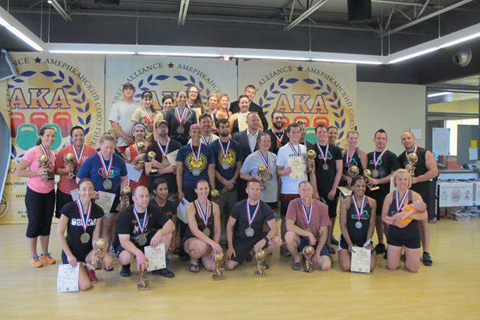2nd Annual Wild West Open: Kettlebell Sport Championships

On July 6 at the Northwest Austin Rec Center, the American Kettlebell Alliance (AKA)—the sanctioned American organization member of the International Union of Kettlebell Lifters (IUKL), the oldest governing body of Kettlebell Sport—held the Second Annual, Wild West Open: Kettlebell Sport Championships. The event was a huge success, bringing out the best in the Western United States, and even one international lifter! We had representatives and teams from Sweden, California (Ice Chamber Kettlebell Team, Orange Kettlebell Club), Washington, Connecticut, and, of course, Texas (Girya Courage Club—my team—Lukes Barbell Club, Full Throttle Ketlebell Club, Red Black Gym, and House of Steel).
It was a true kettlebell lifter's holiday. A day for all of us to get together and celebrate our training by competing and bringing the best out in one another; to let our skills, techniques, and numbers speak for themselves. The energy in the room was synergistic, with each lifter getting huge applause as he or she withstood the ten minutes, delivering his or her best performance, and not just fighting to finish, but sprinting to finish. I finished first in my division: 85 kilogram body weight, 24 kilogram bell Longcycle; 65 reps in ten minutes.
Kettlebell, or Girevoy, Sport is growing more popular with each competition in the West. We are strengthening friendships between nations and building strong cooperation in the sport. Each lifter is getting better, mastering our sport and exchanging experiences with each other to help the sport grow. Girevoy Sport is for healthy living without age limits. A kettlebell in every hand!
Editor's note: Want to learn more about Kettlebell Sport? Henry Marshall provides the 411 below.
You’re probably asking yourself, what is Kettlebell Sport? Let's discuss what it is, its benefits, and its origin.
Skill, strength, endurance, speed, coordination, flexibility, and mental focus are the main components to Kettlebell Sport, also known as Girevoy Sport (GS), a highly challenging power endurance feat. The most important part is the technique of performing the exercises, which comes with the ability to interchange tension and relaxation in combination with breathing.
Kettlebell Sport is classified as a cyclical sport.
Kettlebell Sport competitors, also known as Gireviks, traditionally choose one of two lifts to compete in, both of which test the basics of human movement push and pull in a power endurance manner. The lifts are done for a ten-minute time frame to get as many clean fixated lockouts overhead. The events include:
Long Cycle—combining the momentum of the Clean (pull) with the power of the Jerk (push)
Biathlon—Jerk (push), followed by a 30-minute to one-hour break, then Snatch (pull)
Men’s Jerk and Long Cycle are performed with two bells, an amateur 24 kilograms and a professional 32 kilograms. Women’s Biathlon and Long Cycle are performed with one bell, amateur 16 kilogram and professional 24 kilogram. Men and Women’s Snatch are performed with one bell. Note, one can use a bell lighter than that used in the amateur division, but that would be beginner level.
When one bell is used, you are allowed only one hand switch, and each lifter has ten minutes to complete as many repetitions of the determined lifts as possible without setting the kettlebell(s) down. Although there are not points awarded or deducted for style, it is mandatory that the knees and elbows are straight at the top of each lift, and that the momentum of the bell(s) is stopped overhead in order to receive a count from the judge. If this is not achieved, there is a "no count" for the lift attempt.
When performing Kettlebell Sport exercises, athletes typically have increases in general and special endurance; significant hypertrophy of the back, legs, and arms; and also strengthening the skeletal, cardiovascular, and respiratory systems. During the exercises, working muscle groups perform a large volume of exertion, both dynamic and static. This aids in harmonious development of the muscle and organ systems.
Kettlebell Sport’s origins derive from the 1940s in the old USSR, where it was cultivated in rural groups and the Soviet military. It has grown beyond Russia and its former republics to other European countries, Asia, and North America, and is growing more popular every year.






